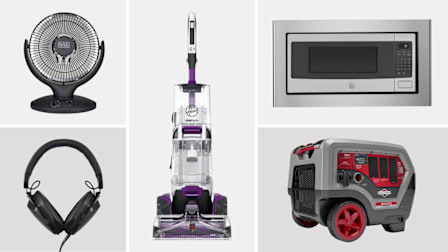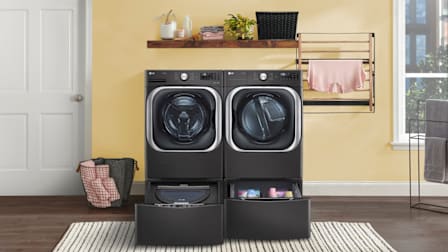How to Minimize Mold in Your Washing Machine
8 tips to help fight the funk in your front-load washer
When you shop through retailer links on our site, we may earn affiliate commissions. 100% of the fees we collect are used to support our nonprofit mission. Learn more.

The average American family does 300 loads of laundry annually, according to Energy Star. And if you happen to own a front-loader, your work doesn’t end there. These machines have a history of developing problems with mold and odors, and while design improvements have reduced the risk, keeping a front-loader mold-free can still involve some dedicated caretaking.
In our latest consumer survey, 16 percent of front-load washer owners reported mold, mildew, and odor issues. These nuisances can damage rubber gaskets and erode consumers’ confidence in front-loaders, with some questioning whether they’re worth the hassle despite their very good cleaning performance and exceptional energy and water efficiency. If you’re in the market for a new front-loader, you may be tempted by new models with features designed to eliminate these odorous issues (more on that below). But if you’re not ready to part with your current front-loader, here are some tips for keeping your machine as fresh as your last load of laundry.
Front-Load Washer Maintenance Tips
Following care instructions in your owner’s manual is a wise first step. Here’s a cheat sheet on what manufacturers, repair technicians, and our own CR laundry expert recommend doing about mold.
1. Combat Residue
It feeds mold. Skip the fabric softener, which may leave residue, and use only high-efficiency (HE) detergents. (Regular detergent is too sudsy for water-efficient washers and will leave behind soap scum.) According to Samsung, HE powder detergent is less likely to build up than liquid detergent. “And don’t use too much detergent,” says Daryl Shuler, a technician for Appliance Doctor in New York City. “The excess builds up, and eventually you’ll see a film” in the dispenser drawer. (CR’s review of the best and worst laundry detergents can help you choose a good one.)
2. Remove Your Clean Laundry ASAP
Transfer wet clothes to the dryer as soon as the cycle ends to keep moisture from lingering.
3. Wipe the Door and Gasket
Use a rag to dry the inside of the door. Gently pull back the gasket, wipe it clean, then dry. And be on the lookout for socks and such that can get stuck here and become moldy. (Even if you own a top-loader, periodically wiping down the circular upper rim of the tub and agitator is a good idea.)
Front-Load Washers with Mold-Fighting Features
If those high-maintenance tips aren’t your speed but you still favor a front-loader, you might consider a machine with specialized settings designed to lessen the occurrence of mold, mildew, and odor.
CR doesn’t typically evaluate optional cycles during our washer performance testing, but in response to concerns about mold in front-loaders, we performed a limited evaluation of GE’s UltraFresh feature when it was introduced in 2020. More recently, we evaluated Whirlpool’s FreshFlow Vent system, a feature on its WFW5720RR model.
The FreshFlow Vent system comprises a trio of features designed to keep clothes fresh and the washer drum clean:
- A post-cycle "Fan Fresh" button that periodically circulates air and tumbles finished loads in the drum for up to four hours
- A "Dry Drum" cycle to reduce excess drum and door moisture after clothes are unloaded
- An antimicrobial rubber door seal to protect against odor-causing bacteria
First, we tested the Whirlpool WFW5720RR for performance and found the washer to be excellent at cleaning clothes. After we removed the load, we monitored the humidity inside the drum. We then ran the Dry Drum cycle (which runs a fan and periodically tumbles the drum for four hours) and recorded the humidity again.
After the clothes were removed, the humidity in the drum measured 80 percent. After using the Dry Drum cycle for four hours, the humidity steadily dropped to 40 percent, and then rose slightly to about 50 percent after the Dry Drum cycle had finished. The gasket, door, and drum appeared dry at the end of the Dry Drum cycle.
We took the same measurements without using the Dry Drum cycle. In this case, the humidity inside the drum registered 85 percent when clothes were first removed and rose slightly to 87 percent before leveling off at 86 percent over the next four hours. The gasket, door, and drum remained visibly wet, though it’s likely all would have eventually dried out if the door were left open.
“We found Whirlpool’s FreshFlow feature reduces excess moisture from the drum, rubber gasket, and door, where mold and mildew tend to collect,” said Rich Handel, CR’s laundry expert and lab supervisor. “Reducing the moisture in the drum will likely reduce the chance for mold and mildew to build up.”
GE’s UltraFresh technology also claims to protect against mold and odor-causing bacteria via fresh-air venting, tumbling, and Microban-treated gaskets, dispensers, and hoses. After clothes are removed, the UltraFresh cycle pulls fresh air into the drum, which spins intermittently for up to eight hours, eliminating the need to wipe down the gasket and door.
We tested two GE Ultra Fresh washers when the company introduced the technology in 2020. The GE GFW850SPNRS and the GFW650SSNWW are no longer in our ratings, but GE offers more models with UltraFresh Vent Systems, including the GE PFW870SPVRS.
In those tests, we did an evaluation similar to the one we did with the Whirlpool. After we removed the clothes, we monitored the humidity inside the drum, both with and without engaging the UltraFresh feature. We found that using the UltraFresh cycle lowered the humidity inside the washer to match that of the room; without it, humidity inside the drum remained above 90 percent. We concluded that even though GE’s UltraFresh Vent System consumed more electricity, it did lower the humidity in the drum compared to not using it.
































